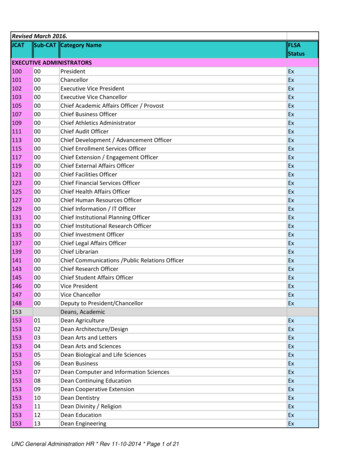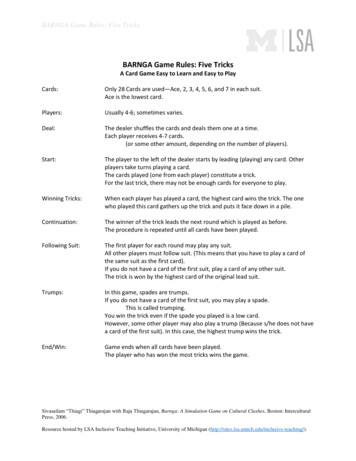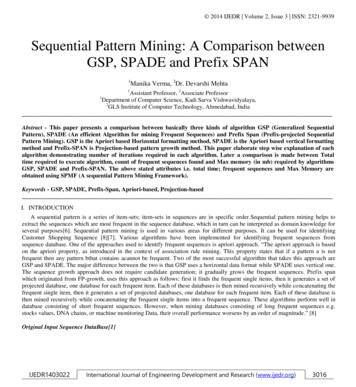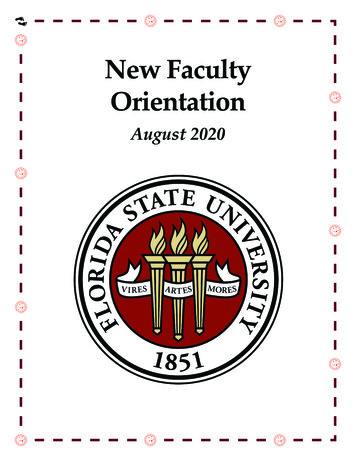
Transcription
II'Morgan Bassichis, Alexander Lee, Dean SpadeAs we write this, queer and trans people across the United States and inmany parts of the world have just celebrated the fortieth anniversary ofthe Stonewall Rebellion. On that fateful night back in June 1969, sexualand gender outsiders rose up against ongoing brutal police violence in aninspiring act of defiance. These early freedom fighters knew all too wellthat the NYPD-"New York's finest"-were the frontline threat to queerand trans survival. Stonewall was the culmination of years of domination,resentment, and upheaval in many marginalized communities coming toa new consciousness of the depth of violence committed by the government against poor people, people of color, women, and queer people bothwithin US borders and around the world. The Stonewall Rebellion, themass demonstrations against the war in Vietnam, and the campaign to15
Captive Genders.free imprisoned Black-liberation activist Assata Shakur were all powerfulexamples of a groundswell of energy demanding an end to the "businessas usual" of US terror during this time.Could these groundbreaking and often unsung activists have imagined that only forty years later the "official" gay rights agenda would belargely pro-police, pro-prisons, and pro-war-exactly the forces theyworked so hard to resist? Just a few decades later, the most visible andwell-funded arms of the "LGBT movement" look much more like acorporate strategizing session than a grassroots social justice movement.There are countless examples of this dramatic shift in priorities. Whatemerged as a fight against racist, anti-poor, and anti-queer police violence .now works hand in hand with local and federal law enforcement agencies-district attorneys are asked to speak at trans rallies, cops march inGay Pride parades. The agendas of prosecutors-those who lock up ourfamily, friends, and lovers-and many queer and trans organizations arebecoming increasingly similar, with sentence- and police-enhancing legislation at the top of the priority list. Hate crimes legislation is tacked onto multi-billion dollar "defense" bills to support US military dominationin Palestine, Iraq, Mghanistan, and elsewhere. Despite the rhetoric of an"LGBT community," transgender and gender-non-conforming people arerepeatedly abandoned and marginalized in the agendas and priorities ofour "lead" organizations-most recently in the 2007 gutting of the Employment Non-Discrimination Act of gender identity protections. Andas the rate of people (particularly poor queer and trans people of color)without steady jobs, housing, or healthcare continues to rise, and healthand social services continue to be cut, those dubbed the leaders of the"LGBT movement" insist that marriage rights are the way to redress theinequalities in our communities.For more and more queer and trans people, regardless of maritalstatus, there is no inheritance, no health benefits from employers, no legalimmigration status, and no state protection of our relationship to ourchildren. Four decades after queer and trans people took to the streetsthrowing heels, bottles, bricks, and anything else we had to ward off police,the official word is that, except for being able to get married and fight inthe military, 2 we are prett:)r much free, safe, and equal. And those of us whoare not must wait our turn until the "priority'' battles are won by the largelywhite, male, upper-class lawyers and lobbyists who know better than us. 3Fortunately, radical queer and trans organizing for deep transformation has also grown alongside this "triclde-down"4 brand of "equality''16
Building an Abolitionist Trans and Queer Movementpolitics mentioned above. Although there is no neat line between officialgay "equality'' politics on the one hand, and radical "justice" politics onthe other, it is important to draw out some of the key distinctions inhow different parts of our movements today are responding to the mainproblems that queer and trans people face. This is less about creating falsedichotomies be.tween "good" and "bad" approaches, and more aboutclarifYing the actual impact that various strategies have, and recognizingthat alternative approaches to the "official" solutions are alive, are politically viable, and are being pursued by activists and organizations aroundthe United States and beyond. In the first column, we identifY some ofthese main challenges; in the second, we summarize what solutions 'arebeing offered by the well-resourced 5 segments of our movement; and inthe third, we outline some approaches being used by more radical andprogressive queer and trans organizing to expand possibilities for broadbased, social-justice solutions to these same problems.The Current LandscapeBIG PROBLEMS"OFFICIAL" SOLUTIONSTRANSFORMATIVE APPROACHESQueer and transpeople, poorpeople, peopleof color, and immigrants haveminimal access toquality healthcareLegalizemarriage to allowpeople with healthbenefits from theirjobs to share withsame-sex partnersStrengthen Medicaid and Medicare;win universal healthcare; fight fortransgender health benefits; enddeadly medical neglect of people instate custodyQueer and transpeople experienceregular and oftenfatal violence frompartners, familymembers, community members,employers, lawenforcement, andinstitutional officialsPass hate crimes legislation to increaseprison sentencesand strengthen local and federal lawenforcement; collectstatistics on rates ofviolence; collaboratewith local and federallaw enforcement toprosecute hate violence and domesticviolenceBuild community relationships and infrastructure to support the healing andtransformation of people who havebeen impacted by interpersonal andintergenerational violence; join withmovements addressing root causesof queer and trans premature death,including police violence, imprisonment, poverty, immigration policies,and lack ofhealthcare and housing17
Captive GendersBIG PROBLEMS110FFICIAL" SOLUTIONSTRANSFORMATIVE APPROACHESQueer and transmembers of themilitary experienceviolence and discriminationEliminate bans onparticipation of gaysand lesbians in USmilitaryQueer and transpeople are targetedby an unfair andpunitive immigration systemEnd the use of immigration policy toLegalize same-sexmarriage to allowcriminalize people of color, exploitsame-sex internationworkers, and maintain the deadlywealth gap between the United Statesal couples to applyfor legal residency for and the Global South; support currentthe non-US citizen . detainees and end ICE raids, deportadons, and police collaborationspouseQueer and transfamilies are vulnerable to legalintervention andseparation fromthe state, institutions, and/ or nonqueer peopleLegalize same sexmarriage to providea route to "legalize"families with two parents of the same sex;pass laws banningadoption discrimination on the basis ofsexual orientationJoin with struggles of queer/trans andnon-queer/trans families of color,imprisoned parents and youth, native families, poor families, m ilitaryfamilies, and people with disabilitiesto win community and family self-determination and the right to keep kids,parents, and other family members intheir families and communitiesInstitutions failto recognize family connectionsoutside of heterosexual marriagein contexts likehospital visitationand inheritanceLegalize same-sexmarriage to formallyrecognize same-sexpartners in the eyesof the lawChange policies like hospital visitation to recognize a variety of familystructures, not just opposite-sex andsame-sex couples; abolish inheritanceand demand radical redistribution ofwealth and an end to poverty18Join with war resisters, radical veterans, and young people to opposemilitary intervention, occupation, andwar abroad and at home, and demandthe reduction/ elimination of "defense"budgets
Building an Abolitionist Trans and Queer MovementBIG PROBLEMS"OFFICIAL", SOLUTIONSAdvocate for "culturalQueer and transcompetency" trainingpeople are disfor law enforcementproportionatelypoliced, arrested,and the constructionof queer and transand imprisoned,and face high rates specific and "genderof violence in state responsive" facilities;create written policiescustody from officials as well asthat say that queerand trans people areother imprisonedor detained people equal to other peoplein state custody; staylargely silent on thehigh rates of imprisonme!'it in queer andtrans communities,communities ofcolor, and poor communitiesTRANSFORMATIVE APPROACHESBuild ongoing, accountable relationships with and advocate for queer andtrans people who are locked up tosupport their daily well-being, healing,leadership, and survival; build communiry networks of care to supportpeople coming out of prison and jail;collaborate with other movements toaddress root causes of queer and transimprisonment; work to abolish prisons, establish communiry support forpeople with disabilities and eliminatemedical and psychatric institutionalization, and provide permanenthousing rather than shelter beds for allpeople without homesI. How Did We Get Here?The streams of conservative as well as more progressive and radical queerand trans politics developed over time and in the context of a rapidlychanging political, economic, and social landscape. Although we can't offer a full history of how these different streams developed and how themore conservative one gained national dominance, we think it is important to trace the historical context in which these shifts occurred. To charta different course for our movements, we need to understand the road we'vetraveled. In particular, we believe that there are two major features of thesecond half of the twentieth century that shaped the context in which thequeer and trans movement developed: (1) the active resistance and challenge by radical movement to state violence, and subsequent systematicbacldash/ and (2) the massive turmoil and transformation of the globaleconomy. 8 Activists and scholars use a range of terms to describe this erain which power, wealth, and oppression were transformed to respond tothese two significant "crises"-including neoliberalism, the "New WorldOrder," empire, globalization, free market democracy, or late capitalism.19
Captive GendersEach term describes a different aspect or "take" on the current historical.moment that we are living in.It is important to be dear that none ofthe strategies ofthe "New WorldOrder" are new. They might work faster, use new technologies, and recruitthe help of new groups, but they are not new. Oppressive dynamics in theUnited States are as old as the colonization of this land and the foundingof a country based on slavery and genocide. However, they have takenintensified, tricky forms in the past few decades-particularly becausegovernments keep telling us those institutions and practices have been"abolished." There were no "good old days" in the United States-justtimes in which our movements and our communities were stronger orweaker, and times when we used different cracks in the system as opportunities for resistance. All in all, we might characterize the past manydecades as a time in which policies and ideas were promoted by powerfulnations and institutions (such as the World Trade Organization and theInternational Monetary Fund) to destroy the minimal safety nets set upfor vulnerable people, dismantle the gains made by social movements, andredistribute wealth, resources, and life changes upward-away from thepoor and toward the elite. 9Below are some of the key tactics that the United States and othershave used in this most recent chapter of our history: Pull Yourself Up by Your Bootstraps, AgainThe US government and its ally nations and institutions in the GlobalNorth helped pass laws and policies that made it harder for workers toorganize into unions; destroyed welfare programs and created the imageof people on welfare as immoral and fraudulent; and created international economic policies and trade agreements that reduced safety nets,worker rights, and environmental protections, particularly for nations inthe Global South. Together, these efforts have dismantled laws and socialprograms meant to protect people from poverty, violence, sickness, andother harms of capitalism.EXAMPLE: In the early 1990s, the North American Free TradeAgreement (NAFTA) was implemented by the United States underDemocratic President Clinton to make it easier for corporationsto do business across borders between the United States, Mexico,and Canada. Unfortunately, by allowing corporations to outsourcetheir labor much more cheaply, the agreement also led to the loss.20
Building an Abolitionist Trans and Queer Movementof hundreds of thousands of US jobs and wage depression even in"job receiving" countries. 10 Additionally, human rights advocateshave documented widespread violations of workers rights sinceNAFTA, including "favoritism toward employer-controlled unions;firings for workers' organizing efforts; denial of collective bargainingrights; forced pregnancy testing; mistreatment of migrant workers;life-threatening health and safety conditions"; and other violationsof the right to freedom of association, freedom from discrimination,and the right to a minimum wage. 11 Loss of jobs in the United Statesreduced the bargaining power of workers, now more desperate forwages then ever, and both wages and benefits declined, with manyworkers now forced to work as "temps" or part-time with no benefitsor job security.EXAMPLE: In 1996, President Clinton signed into law the PersonalResponsibility and Work Opportunity Reconciliation Act, which effectively dismantled what existed of a welfare state-creating a rangeof restrictive and targeting measures that required work, limited aid,and increased penalties for welfare recipients. The federal governmentabdicated its responsibility to provide minimal safety nets for poorand worldng-class people, using the rhetoric of "personal responsibility'' and "work" to justifY the exploitation and pain caused by capitalism and racism. Sexist, racist images of poor people as immoral,fraudulent drug addicts fueled these policy changes. Since then, different cities have adopted local measures to gut economic safety nets forpoor, homeless, and worldng-class people. In San Francisco, MayorNewsom's notorious 2002 "Care Not Cash" program slashed welfarebenefits for homeless people, insisting that benefits given to the homeless were being spent on "drugs and alcohol." 12 ScapegoatingThe decrease in manufacturing jobs and the gutting of social safety netsfor the poor and working class created a growing class of people who weremarginally employed and housed, and forced into criminalized economiessuch as sex work and the drug trade. This class of people was blamedfor the poverty and inequity they faced-labeled drug dealers, welfarequeens, criminals, and hoodlums-and were used to justifY harmful policies that expanded violence and harm. At the same time, criminal penalties for behaviors associated with poverty, like drug use, sleeping outside, .21
Captive Gendersgraffiti, and sex work have increased in many parts the United States, andresources for policing these ldnds of "crimes" has also increased.EXAMPLE: In the 1990s, states across the United States beganto sign into law so-called "Three Strikes" measures that mandatedstandard, long (often life) sentences for people convicted of threefelonies, many including non-violent offenses. California's law has resulted in sentences of twenty-five years or more for people convictedof things like shoplifting. The popularity of Three Strikes laws havebeen fueled by a growing cultural obsession with criminality andpunishment that relies on images of violent and dangerous "careercriminals" while functioning to imprison enormous numbers of lowincome people and people of color whose behaviors are the directresults of economic insecurity.EXAMPLE: Under President Clinton's 1996 welfare reforms, anyone convicted of a drug-related crime is automatically banned forlife from receiving cash assistance and food stamps. Some states havesince opted out of this ban, but for people living in fifteen states, thisdraconian measure presents nearly insurmountable barriers to becoming self-sufficient. Unable to receive cash assistance and subject to jobdiscrimination because of their criminal histories, many people withdrug-related convictions go back into the drug trade as the only wayto earn enough to pay the rent and put food on the table. The lifetimewelfare ban has been shown to particularly harm women and theirchildren. 13 Fear-MongeringThe government and corporate media usedxenophobic, and misogynist fear-mongering to distract us from increasing economic disparityand a growing underclass in the United States and abroad. The War onDrugs in the 1980s and the Bush Administration's War on Terror, both ofwhich are ongoing, created internal and external enemies ("criminals" and"terrorists") to blame for and distract from the ravages of racism, capitalism, patriarchy, and imperialism. In exchange, these enemies (and anyone who looked like them) could be targeted with violence and murder.During this time, the use of prisons, policing, detention, and surveillanceskyrocketed as the government declared formal war against all those whoit marks as "criminals" or "terrorists."22
Building an Abolitionist Trans and Queer MovementEXAMPLE: In the 1980s, the US government declared a "War onDrugs" and drastically increased mandatory sentences for violatingdrug prohibition laws. It also created new prohibitions for accessingpublic housing, public benefits, and higher education for peoplevicted of drug crimes. The result was the imprisonment of over onemillion people a year, the permanent marginalization and disenfranchisement for people convicted, and a new set of military and foreignpolicy intervention justifications for the United States to take brutalaction in Latin America.EXAMPLE: Following the September 11, 2001 attacks on the WorldTrade Center in New York, politicians manipulated the Americanpublic's fear and uncertainty to push through a range of new laws andpolicies justified by a declared "War on Terror." New legislation likethe PATRIOT Act, the Immigrant Registration Act, and the Real IDAct, as well as new administrative policies and practices, increased thesurveillance state, reduced even the most basic rights and living standards of immigrants, and turned local police, schoolteachers, hospitalworkers, and others into immigration enforcement officers. The Myth That Violence and Discrimination Are Just About"Bad" IndividualsDiscrimination laws and hate crimes laws encourage us to understandoppression as something that happens when individuals use bias to denysomeone a job because of race or sex or some other characteristic, orbeat up or kill someone because of such a characteristic. This way ofthinking, sometimes called the "perpetrator perspective," 14 makes people ·think about racism, sexism, homophobia, transphobia, and ableism interms of individual behaviors and bad intentions rather than wide-scalestructural oppression that often operates without some obvious individual actor aimed at denying an individual person an opportunity. Theviolence of imprisoning millions of poor people and people of color,for example, can't be adequately explained by finding one nasty racist individual, but instead requires looking at a whole web of institutions, policies, and practices that make it "normal" and "necessary'' towarehouse, displace, discard, and annihilate poor people and people ofcolor. Thinking about violence and oppression as the work of "a few badapples" undermines our· ability to analyze our conditions systemicallyand intergenerationally, and to therefore organize for systemic change.23
Captive GendersThis narrow way of thinking about oppression is repeated in law, policy,the media, and nonprofits.EXAMPLE: Megan's Laws are statutes that require people convictedof sexual offenses to register and that require this information be available to the public. These laws have been passed in jurisdictions aroundthe country in the last two decades, prompted by and generating public outrage about child sexual abuse (CSA). Studies estimate that 1 in3 people raised as girls and 1 in 6 people raised as boys were sexuallyabused as children, as a result of intergenerational trauma, community- and state-sanctioned abusive norms, and alienation. Rather thanresourcing comprehensive programs to support the healing of survivors and transformation of people who have been sexually abusive,or interrupt the family and community norms that contribute to thewidespread abuse of children, Megan's Laws have ensured that peopleconvicted of a range of sexual offenses face violence, the inability tofind work or a place to live, and severely reduced chances of recovely and healing. Despite the limited or nonexistent deterrent effectof such laws, they remain the dominant "official" approach to thesystemic problems of CSA. 15EXAMPLE: As we write this, the Matthew Shepard Local Law Enforcement Enhancement Act has recently passed in the US Senate,and if signed into law would give 10 million to state and local lawenforcement agencies, expand federal law enforcement power focusedon hate crimes, and add the death penalty as a possible punishmentfor those convicted. This bill is heralded as a victory for transgenderpeople because it will mal{e gender identity an included category inFederal Hate Crimes law. Like Megan's Law, this law and the advocacysurrounding it (including advocacy by large LGBT nonprofit organizations) focus attention on individuals who ldll people because oftheir identities. These laws frame the problem of violence in our communities as one of individual "hateful" people, when in reality, transpeople face short life-spans because of the enormous systemic violencein welfare systems, shelters, prisons, jails, foster care, juvenile punishment systems, and immigration, and the inability to access basic survival resources." These laws do nothing to prevent our deaths, they justuse our deaths to expand a system that endangers our lives and placesa chokehold on our communities. 1624
Building an Abolitionist Trans and Queer Movement Undermining Transformative OrganizingThe second half of the twentieth century saw a major upsurge in radicaland revolutionary organizing in oppressed communities in the UnitedStates and around the world. This powerful organizing posed a significant threat to the legitimacy of US power and capitalist empire morebroadly, and therefore needed to be contained. These movements wereundermined by two main strategies: First, the radical movements of the1960s and '70s were criminalized, with the US government using tacticsof imprisonment, torture, sabotage, and assassination to target and destroy groups like the Black Panthers, American Indian Movement, andYoung Lords, among others. Second, the growth of the nonprofit sectorhas seen social movements professionalizing, chasing philanthropic dollars, separating into "issue areas," and moving toward social services andlegal reform projects rather than radical projects aimed at the underlyingcauses of poverty and injustice. 17 1hese developments left significant sections of the radical left traumatized and decimated, wiping out a generation of revolutionaries and shifting the terms of resistance from revolutionand transformation to inclusion and reform, prioritizing state- and foundation-sanctioned legal reforms and social services over mass organizingand direct action.EXAMPLE: The FBI's Counter-Intelligence Program (COINTELPRO) is a notorious example of the US government's use of infiltration, surveillance, and violence to overtly target dissent and resistance.COINTELPRO was exposed when internal government documentswere revealed that detailed the outrageous work undertaken by thefederal government to dismantle resistance groups in the 1960s and'70s. Although the program was dissolved under that name, the tacticscontinued and can be seen today in current controversies about wiretapping and torture as well as in the USA PATRIOT Act. Overt action to eliminate resistance and dissent here is as old as the Europeancolonization of North America. 18EXAMPLE: In the wake of decades of radical organizing by people inwomen's prisons and activists on the outside decrying systemic medicalneglect, sexual violence, and the destruction of family bonds, California legislators in 2006 proposed a so-called "gender responsive corrections" bill that would allow people in women's prisons to live withtheir children and receive increased social services. To make this plan25
Captive Genderswork, the bill called for millions of dollars in new prison construction.The message of "improving the lives of women prisoners" and creatingmore "humane" prisons-rhetoric that is consistently used by thosein power to distract us from the fundamentally violent conditions ofa capitalist police state-appealed to liberal, well- intentioned feministresearchers, advocates, and legislators. Anti-prison organizations suchas Oakland-based Justice Now and others working in solidarity withthe resounding sentiment of people in women's prisons, pointed outthat this strategy was actually just a back door to creating 4,500 newprison beds for women in California, yet again expanding opportunities to criminalize poor women and transgender people in one of thenation's most imprisoning states. 19 The Hero MindsetThe United States loves its heroes and its narratives-Horatio Alger, ragsto-riches, "pull yourself up by your bootstraps," streets "paved with gold,"the rugged frontiersman, the benevolent philanthropist, and Obama assavior, among others. These narratives hide the uneven concentration ofwealth, resources, and opportunity among different groups of people-theways in which not everybody can just do anything if they put their minds toit and work hard enough. In the second half of the twentieth century, thisindividualistic and celebrity-obsessed culture had a deep impact on socialmovements and how we write narratives. Stories of mass struggle becamestories of individuals overcoming great odds. The rise of the nonprofit asa key vehicle for social change bolstered this trend, giving incentives tocharismatic leaders (often executive directors, often people with privilege)to frame struggles in ways that prioritize symbolic victories (big court cases,sensationalistic media coverage) and ignore the daily work of building abase and a movement for the long haul. This trend also compromises theaccountability of leaders and organizations to their constituencies, and devalues activism in the trenches.EXAMPLE: Rosa Parks is ·one of the most well-known symbols ofresistance during the Mrican American Civil Rights movement inthe 1950s and 1960s. She is remembered primarily for "sparking" theMontgomery Bus Boycott and as the "mother of the civil rights movement."20 In popular mythology, Ms. Parks was an ordinary womanwho simply decided one day that she would not give up her seat to awhite person in a "lonely act of defiance." 21 In reality, Ms. Parks was26
Building an Abolitionist Trans and Queer Movementan experienced civil rights activist who received political educationand civil disobedience training at the well-known leftist HighlanderFolk School, which still exists today. Ms. Parks's refusal to give up herseat was far from a "lonely act," but was rather just one in a series ofcivil disobediences by civil rights leaders to target segregation in public services. The Civil Rights Movement of the period was a productof the labor and brilliance of countless New-World Mrican enslavedpeople, Mrican American people, and their allies working since before the founding of the United States, not simply attributable to anyone person. The portrayal of mass struggles as individual acts hides adeeper understanding of oppression and the need for broad resistance.EXAMPLE: Oprah's well-publicized giveaways 22-as well as a rangeof television shows that feature "big wins" such as makeovers, newhouses, and new cars-have helped to create the image of social changein our society as individual acts of "charity'' rather than concerted efforts by mass groups of people to change relationships of power. Theseportrayals affirm the false idea that we live in a meritocracy in whichany one individual's perseverance and hard work are the only keysneeded to wealth and success. Such portrayals hide realities like theracial wealth divide and other conditions that produce and maintaininequality on a group level, ensuring that most people will not riseabove or fall below their place in the economy, regardless of their individual actions. In reality, real social change that alters the relationshipsof power throughout history have actually come about when largegroups of people have worked together toward a common goal.Together, the tactics that we describe above function as a strategyof counter-revolution-an attempt to squash the collective health and political will of oppressed people, and to buy off people with privilege inorder to support the status quo. This is a profoundly traumatic processthat deepened centuries of pain, loss, and harm experienced by people ofcolor, immigrants, queer and trans people, women, and others marked as"disposable." For many of us, this included losing our lives and our lovedones to the devastating government-sanctioned HIV/AlDS pandemic andongoing attacks from family, neighbors, and government officials.Perhaps one of the most painful features of this period has been theseparating of oppressed communities and movements from one another.Even though our communities are all overlapping and our struggles for27
Captive Gendersliberation are fundamentally linked, the "divide and conquer" strategyof the "New World Order" has taught us to think of our identities andstr
punitive immigra- al couples to apply wealth gap between the United States tion system for legal residency for and the Global South; support current the non-US citizen . detainees and end ICE raids, deporta-spouse dons, and police collaboration Queer and trans Legalize same sex Join with struggles of queer/trans and











